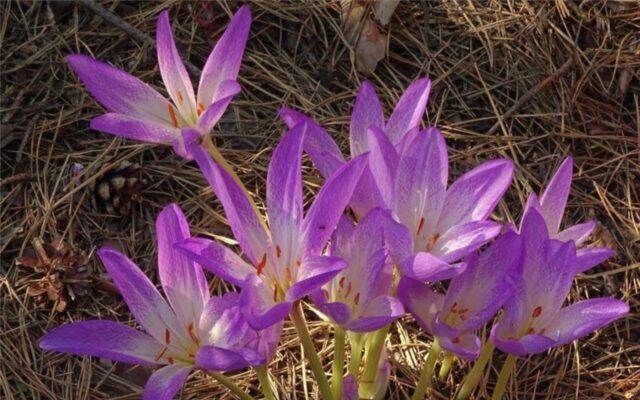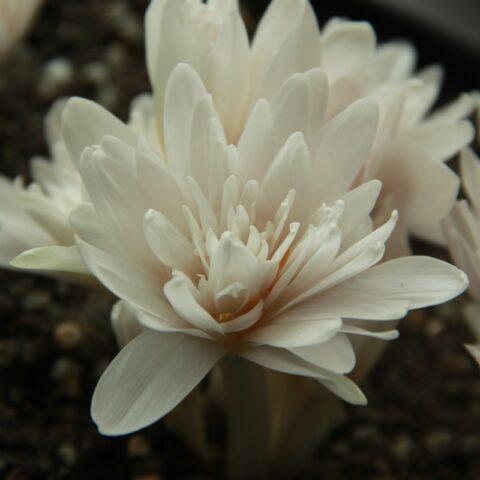Content
- 1 Description of autumn colchicum
- 2 Where does autumn crocus grow?
- 3 Differences between autumn colchicum and crocus
- 4 Varieties of autumn colchicum
- 5 Reproduction methods
- 6 Planting and caring for the autumn crocus flower
- 7 Diseases and pests
- 8 Medicinal properties of autumn crocus and contraindications
- 9 Conclusion
Autumn colchicum (Colchicum autumnale) is a perennial herbaceous plant, also called colchicum. Georgia is considered its homeland, from where the culture spread to different countries of the world. The plant has received universal recognition for the elegant beauty of its flowers and the variety of their shades. The peculiarity of the crop is that its shoots and leaves grow in the spring, and flowering occurs in the fall, when all garden crops are already preparing for winter. This contributed to the growing popularity of the plant as an element of landscape design. In addition, planting and caring for autumn crocus does not cause difficulties even for novice gardeners. But there are certain features that should not be ignored.

Colchicum is considered poisonous because it contains alkaloids.
Description of autumn colchicum
Colchicum is a bulbous plant with a short growing season. During the winter, its above-ground part dies off completely, and with the arrival of spring, the growing season resumes. Autumn colchicum grows a large number of short shoots and narrow elongated leaves with parallel veins. The height of the plant in spring does not exceed 15 cm. With the onset of the growing season, the autumn crocus stops and its above-ground part dries out. With the arrival of autumn, colchicum flower stalks appear, but without leaves.
Colchicum buds are tulip-shaped or bell-shaped. Each of them includes six petals. Their color can be white, pink, lilac, purple, depending on the variety. The flowers are simple, at the moment of full opening their diameter reaches 4-5 cm. Six stamens can be seen inside the buds.
During pollination, a three-lobed ovary is formed. The fruit of the autumn crocus is a round capsule, inside of which there are numerous small seeds. When ripe, it opens its three valves, according to the number of carpels.
The underground part of the plant is presented in the form of a corm. If you cut it, then inside you can see a dense, uniform core without scales. Growing, one plant can occupy up to 20 square meters. cm area. After the spring growing season, the colchicum corm begins to actively grow and accumulate strength for autumn flowering. At the end of it, the main bulb dies off completely, but leaves behind 2-3 children.
Where does autumn crocus grow?
Under natural conditions, colchicum can be found in Europe, except Scandinavia, North America, the Mediterranean, as well as in Western and Central Asia. Autumn colchicum prefers to grow on damp forest edges and in damp meadows. Thanks to the unpretentiousness of the plant, it began to be cultivated in all countries with a temperate climate.
Differences between autumn colchicum and crocus
These two plants are often confused with each other, as they are very similar in appearance. But knowing their characteristic differences, you can easily determine the type of culture.

Colchicum flowers are much larger
The main signs of autumn colchicum and crocus:
- The leaves of the first are wide, earth-green in color, and glossy. While the second has narrow, matte plates, with a white stripe along the edges.
- Colchicum has six stamens inside the flower, while the second has only three.
- The corms of the crocus have a regular shape, but in the autumn crocus they are larger, and the growing point is shifted to the side from the top.
- The shade of the petals of colchicum is mainly pink or white, while that of crocus is predominantly blue-violet.
- Autumn colchicum also differs in chemical composition. It contains a large number of alkaloids, a high concentration of which is concentrated in the underground part of the plant. And crocus is completely harmless to humans and animals.
Varieties of autumn colchicum
Thanks to the selection carried out, plant species were obtained not only with other shades, but also with double flowers. The developed varieties are characterized by high decorative qualities. In addition, they have a longer flowering period.Therefore, you should familiarize yourself with the most popular of them, as they have received universal recognition among gardeners.
Beaconsfield
Hybrid variety of autumn colchicum. Characterized by the large size of simple tulip-shaped flowers. At the same time, the tube of the glass of the Beckinfield variety has a white tint, and the upper limb is lilac-pink. The height of the plant when flower stalks form reaches 20-30 cm.

The petals of the Beckinfield variety also have a small checkerboard pattern.
Lilac Wonder
The variety is distinguished by large tulip-shaped buds. Flowering occurs in September-October, depending on the climate of the region. The shade of the petals of the Lilac Vande variety is deep purple. There is a white spot in the center of a simple flower. The height of the plant reaches 30 cm.

Autumn colchicum Lilac Vande is characterized by bright and abundant flowering
Double Alboplenum
One of the most beautiful varieties of autumn colchicum. It is distinguished by large terry buds of snow-white color. The autumn crocus flower Double Alboplene (pictured below) begins to form them in mid-September or early October. The height of the plant reaches 10-20 cm. It can be grown in sunny or partial shade. The diameter of its flowers when fully opened is 8-10 cm.

Double Alboplen easily adapts to any climatic conditions
Album
Another variety with white buds. Its flowers are tulip-shaped and simple. Six stamens with yellow anthers are clearly visible in the center. The flowering period of the Album variety begins at the end of September or in mid-October if the weather is rainy.The height during the formation of peduncles reaches 30 cm.

The Album variety is characterized by increased endurance
Pleniflorum
Terry variety of autumn colchicum. It has bright pink petals. The diameter of the buds when fully opened reaches 8-9 cm. The height of the plant is 20-25 cm. The flowering period of the Pleniflorum variety begins in early October and lasts about 10-12 days in the presence of favorable conditions.

The Pleniforum variety is characterized by lush, long-lasting flowering
Reproduction methods
Autumn crocus can be propagated by daughter corms and seeds. The first method allows you to get new seedlings without much difficulty, but there will be a limited number of them. Moreover, it can be carried out for plants that are at least three years old.
To do this, you should dig up a colchicum bush in the fall. You can determine the need to divide it by its sparse flowering, despite the large size of the bush. After the children are separated, they must be immediately placed in a permanent place.
The seed method of propagating the crop is more labor-intensive. But it makes it possible to obtain a large number of young seedlings at the same time. Colchicum seeds should be planted immediately after collection in open ground. This will allow them to undergo natural stratification in winter. For the plant, you need to select a sunny, open area and dig it up. Then carefully level the surface of the soil and simply scatter the seeds on top. When finished, water the beds generously using sprinkling, which will allow them to be deepened into the soil by 1-2 cm.
Autumn colchicum seeds, even under favorable conditions, can germinate for several years.When they get stronger and reach a height of 5 cm, the seedlings can be transferred to a flower bed.

Colchicum from seeds blooms 6-7 years after planting
Planting and caring for the autumn crocus flower
In order for the plant to please the eye with its flowering every year and to grow its daughter bulbs well, it is necessary to provide it with favorable conditions. Therefore, you should choose the right place for the autumn colchicum, plant it within a clearly defined time frame and ensure proper care in the future. Indeed, despite the fact that this culture is undemanding, there are still certain features that need to be paid attention to.
When to Plant Colchicum Bulbs in the Fall
It is necessary to plant planting material in the first half of September. This will give the autumn crocus an opportunity to fully take root before the arrival of constant cold weather. In this case, the plant will survive the winter without problems and begin the growing season with the arrival of spring.
Requirements for place and soil
For autumn colchicum, it is recommended to choose slightly shaded areas under the canopy of shrubs and trees. It is also possible to grow it in a sunny open area. However, in this case, the height of the plant will be lower and the duration of flowering will be reduced. The soil for autumn colchicum should be light and well-drained. The best option is loamy and sandy loam soil with a low or neutral acidity level.
Two weeks before planting autumn crocus, you need to dig up the area and add humus at the rate of 10 kg per meter of area.
How to plant bulbs
Pre-planting material of the plant must be disinfected. To do this, prepare a working solution of the Maxim fungicide and soak the colchicum corms in it, according to the attached instructions.
Planting should be done in holes at a distance of 20 cm from each other. Place a layer of river sand at the bottom of each of them, which will prevent the bottom from rotting during prolonged rainy weather. A layer of earth should be poured on top of it and a pinch of superphosphate and wood ash should be added. After this, the fertilizer should be thoroughly mixed with the soil to avoid burning the corms. At the end of the procedure, the bed with autumn colchicum should be watered abundantly using the sprinkling method.

The planting depth for small bulbs is 6-8 cm, and for large ones - 10-15 cm.
Aftercare
Autumn colchicum is one of the undemanding crops. Therefore, caring for it is not particularly difficult.
There is no need to water the plant in the spring, since during this period there is enough moisture in the soil. It is important to moisturize only in the fall before flowering in the absence of seasonal rains.
Colchicum should be fed annually in early spring at the beginning of the growing season. During this period, organic matter or urea should be used to increase green mass. It is recommended to apply fertilizer a second time in mid-May. Potassium sulfate should be used at this time to help prepare the corm for fall flowering.
Autumn colchicum is characterized by high frost resistance. But, despite this, experienced gardeners recommend covering crop plantings with mulch for the winter. Spruce branches, humus, dry leaves, and compost are suitable for this.The covering layer should be 7-8 cm. It must be removed in early spring, without waiting for sustained heat, otherwise the corms may dry out.
Diseases and pests
Autumn colchicum has high natural immunity. Therefore, it rarely suffers from diseases and pests. But if the growing conditions are inappropriate, its stability decreases.
Damage to the plant can be caused by slugs that feed on young leaves and flower stalks. To repel the pest, it is recommended to sprinkle the soil between plantings of colchicum with wood ash, crushed shell shell or tobacco dust.
During prolonged rainy weather or excessive watering, the plant suffers from gray rot. The disease can be recognized by the characteristic plaque on the leaves and flowers. For treatment, it is recommended to spray the crocus with a solution of the drug “Skor”, “Hom” or “Topaz”.
Medicinal properties of autumn crocus and contraindications
Colchicum has a number of healing properties. It has found application in folk and traditional medicine. In the first case, products are prepared on its basis to help treat gout and rheumatism. And in the second, the plant is used for oncology and neurological diseases.
In some cases, the use of autumn crocus for medicinal purposes can be harmful to health.
Contraindications:
- stomach bleeding;
- last stage of cancer;
- reduced hematopoiesis process;
- respiratory diseases;
- age up to 14 years;
- individual intolerance.
Conclusion
Planting and caring for autumn crocus, taking into account the life cycle of the plant and its requirements, will allow it to fully develop and delight with lush flowering. Colchicum looks especially beautiful when planted in groups with different shades of buds and the same flowering period. This makes it possible to extend summer and add bright colors to the dull rainy days of autumn.








